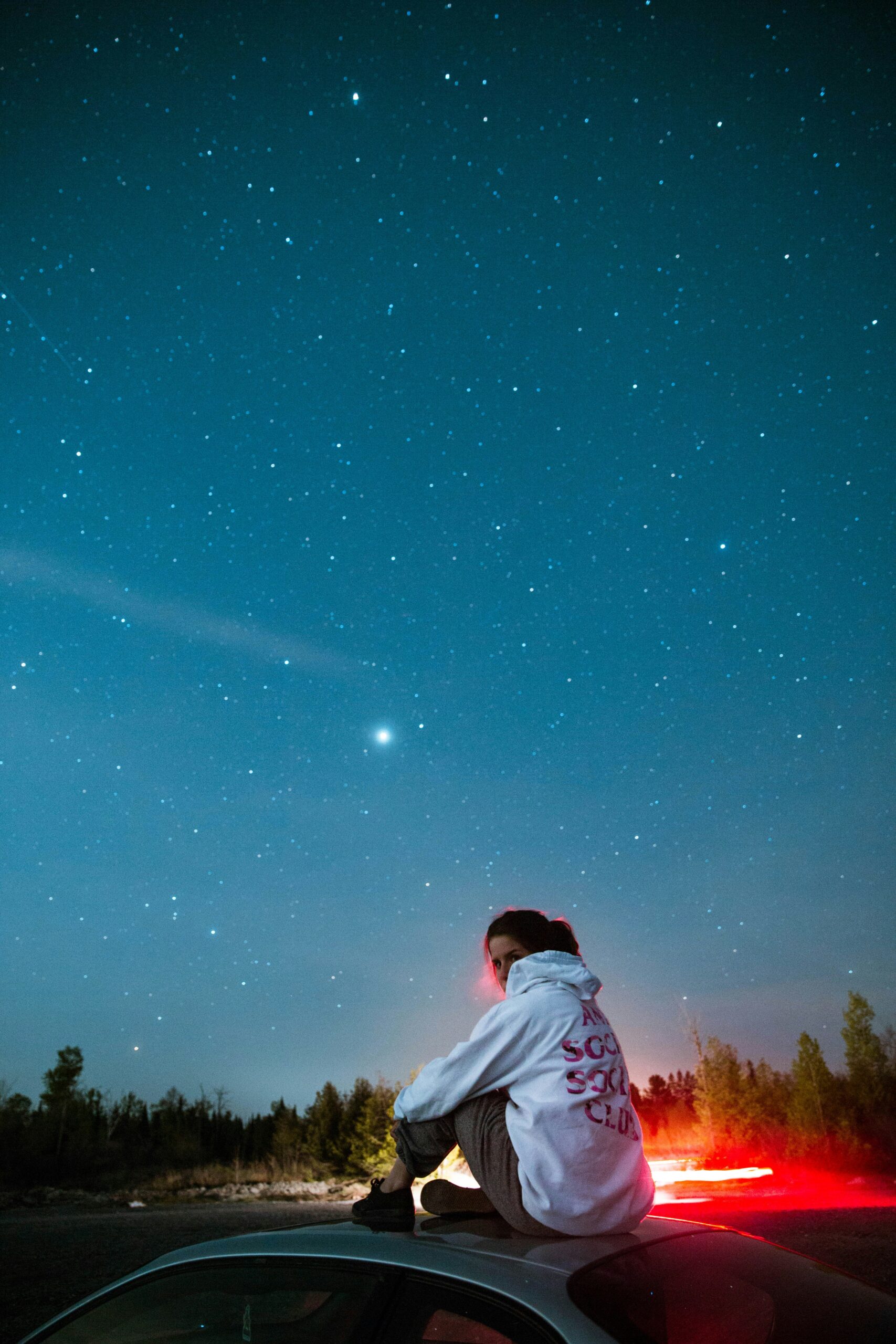Imagine being able to marvel at the beauty of the night sky, capturing the enchanting sight of distant stars and constellations, without the need for a cumbersome telescope. You might be surprised to discover that there is a simpler and more accessible way to delve into the world of stargazing – binoculars. Yes, those handheld devices that are typically associated with bird-watching and sporting events can also unlock the wonders of the universe, allowing you to observe celestial bodies with astonishing clarity and detail. In this article, we will explore the possibilities of using binoculars for stargazing and unveil the incredible experiences they can offer.

Understanding the Fundamental Difference Between a Telescope and Binoculars
Definition and basic mechanics of a telescope
A telescope is an optical instrument designed to observe celestial objects by collecting and focusing light. It consists of a set of lenses or mirrors that gather and magnify the light, allowing for detailed observations of distant stars, galaxies, and planets. Telescopes often have a larger aperture, which allows more light to enter the instrument, resulting in enhanced visibility and image clarity.
Definition and basic mechanics of binoculars
On the other hand, binoculars are handheld optical devices consisting of two telescopes mounted side by side, enabling simultaneous use by both eyes. Binoculars are designed for a wide range of applications, including nature observation, birdwatching, and even stargazing. They are lightweight, compact, and portable, making them a convenient choice for outdoor activities. Binoculars generally have smaller apertures compared to telescopes, leading to a more limited gathering of light.
Understanding the inherent differences between the two
While both telescopes and binoculars are used for observing celestial objects, they differ significantly in their design, mechanics, and purpose. Telescopes are specialized instruments solely intended for stargazing and astronomical observations. With their larger apertures, telescopes gather more light, allowing for higher magnification and the ability to observe faint and distant objects in great detail.
Binoculars, although not specifically designed for astronomy, can still be used for stargazing. However, due to their smaller apertures, binoculars have limitations when it comes to observing faint objects or distant celestial bodies. Binoculars are better suited for capturing wider views of the night sky, making them a popular choice for obtaining a broader perspective and observing constellations.
Using Binoculars for Stargazing: An Overview
Why binoculars are a viable alternative
Binoculars offer numerous advantages for stargazing enthusiasts. Their portability and ease of use make them an excellent choice for beginners and casual observers who do not wish to invest in a telescope. Binoculars provide a wider field of view, allowing for a more immersive stargazing experience and making it easier to locate constellations and star clusters. Moreover, binoculars are often more affordable compared to telescopes, making them an accessible option for many skywatchers.
Limitations of binoculars for stargazing
While binoculars offer unique benefits, it is important to understand their limitations for stargazing. Due to their smaller apertures, binoculars have limited light-gathering capabilities, which may restrict their effectiveness when observing objects with low brightness, such as distant galaxies or faint nebulae. Additionally, binoculars may not provide the same level of image detail as telescopes, resulting in less precise observations of planets or lunar features. However, these limitations can often be mitigated by selecting the right pair of binoculars and optimizing the observing conditions.
Understanding the optimal conditions for stargazing with binoculars
To make the most of your stargazing experience with binoculars, it is essential to choose the right observing conditions. Finding a location away from light pollution is crucial for enhancing visibility and improving the contrast of celestial objects. Additionally, selecting nights with clear skies and minimal atmospheric turbulence will enhance the viewing experience with binoculars. Patiently adjusting your eyes to the darkness will also help you perceive fainter objects and fully appreciate the wonders of the night sky.
Choosing the Right Binoculars for Stargazing
Understanding magnification and how it impacts the viewing experience
When selecting binoculars for stargazing, it is important to consider the magnification power. Higher magnification allows for closer views of celestial objects, but it also narrows the field of view. While higher magnification may seem desirable, it can make it more challenging to locate and track objects in the vastness of the night sky. For stargazing purposes, a lower to moderate magnification (around 7x to 10x) is often recommended, as it strikes a balance between detail and a wider field of view.
Examining the importance of lens size
Another crucial consideration when choosing binoculars for stargazing is the size of the lenses, often referred to as the aperture. Larger lenses allow more light to enter the binoculars, resulting in brighter and clearer images. For stargazing, binoculars with an aperture between 40mm to 50mm are generally considered sufficient. However, it is important to note that larger lenses may also increase the weight and size of the binoculars, affecting their portability and ease of use.
Aperture, field of view, and other crucial specifications
In addition to magnification and lens size, binocular specifications such as field of view and exit pupil diameter are important factors to consider. A wider field of view allows for better navigation across the night sky, making it easier to locate constellations and moving objects like meteors. The exit pupil diameter, determined by dividing the lens size by the magnification, affects the brightness of the image. Optimal exit pupil diameter for stargazing is generally around 5mm to 7mm, as it matches the typical dilation of the human eye in low-light conditions.
Binocular Features that Enhance Stargazing
Appreciating the importance of high-quality optics
When selecting binoculars for stargazing, investing in high-quality optics is essential. Optics play a significant role in determining the clarity, brightness, and overall image quality. Look for binoculars with multi-coated lenses, as they reduce glare and maximize light transmission, resulting in sharper and more vivid views. Additionally, binoculars with high-quality prisms, preferably roof prisms, ensure optimum light reflection and minimize image degradation.
How image stabilization can improve the experience
Image stabilization is an innovative feature available in some binoculars that helps compensate for hand movements, providing a more stable and clearer image. This technology, often referred to as “stabilized binoculars,” is particularly valuable for stargazing, as it minimizes the shake and vibrations that can hinder the observation of celestial objects. While stabilized binoculars may come at a higher cost, they offer an immersive and steady viewing experience, especially when observing for extended periods.
Why some binoculars are fitted with filters for light pollution
Light pollution from artificial sources can significantly impact the visibility and contrast of celestial objects. Some binoculars come with built-in filters specifically designed to mitigate the effects of light pollution. These filters selectively block certain wavelengths of light, allowing for clearer and more detailed observations of celestial objects. When stargazing in urban or heavily populated areas with substantial light pollution, binoculars with light pollution filters can help enhance the view and reveal more of the night sky’s wonders.

Practical Tips for Successful Stargazing with Binoculars
Steadying the binoculars for clear viewing
To achieve clear and stable views while using binoculars for stargazing, it is important to steady them to minimize shakiness. Holding binoculars against a stable surface, such as a tripod or steady object, can greatly enhance image stability, especially when observing for extended periods. Alternatively, using a harness or tripod adapter specifically designed for binoculars can ensure a secure and comfortable grip, reducing hand fatigue and improving overall stability.
Understanding the best stargazing conditions
The quality of the stargazing experience is heavily influenced by the observing conditions. Choosing nights with clear skies and minimal atmospheric turbulence is paramount for optimal viewing with binoculars. Avoiding nights with high humidity or atmospheric instability can help reduce the haziness or distortions that may affect the clarity of celestial objects. Additionally, giving your eyes time to adjust to the darkness will improve your ability to perceive fainter objects and appreciate the full beauty of the night sky.
Choosing the right location for stargazing
Selecting a suitable location is crucial for successful stargazing with binoculars. Ideally, find a spot away from bright city lights and other sources of light pollution to maximize visibility. Rural areas or designated dark sky sites offer darker skies, allowing for clearer views of celestial objects. Furthermore, consider the landscape and surroundings when choosing a location. Avoid obstructions such as trees or buildings that may obstruct your field of view and limit the range of observations.
Exploring Constellations and Star Clusters with Binoculars
Which constellations and star clusters are visible with binoculars
Binoculars provide an excellent opportunity to explore the night sky and discover constellations and star clusters. Numerous constellations, such as Orion, Ursa Major, and Cygnus, are easily recognizable and can be observed with binoculars. Star clusters, such as the Pleiades and the Beehive cluster, reveal stunning details with the aid of binoculars. These celestial objects offer a wealth of beauty and fascination, characterized by intricate patterns and unique arrangements of stars.
How binocular vision can enhance the viewing experience
One of the primary advantages of using binoculars for stargazing is the ability to utilize binocular vision. By observing celestial objects with both eyes simultaneously, the brain merges the two images, creating a three-dimensional perception of depth. This adds a sense of immersion and realism to the viewing experience, allowing for a more engaging and captivating exploration of the night sky.
Mapping the night sky: helpful tools and apps
To aid in locating constellations and star clusters with binoculars, various tools and smartphone apps are available. Star charts, either in physical or digital form, provide detailed maps of the night sky, highlighting the positions of celestial objects at different times of the year. Smartphone apps, with augmented reality features, enable real-time sky tracking, displaying constellations and star clusters directly on the screen by aligning with your device’s orientation. These tools can greatly enhance your ability to navigate and identify celestial wonders with binoculars.

Spotting Planets with Binoculars
Which planets can be seen without a telescope
While binoculars may not have the same level of magnification as a telescope, they can still reveal fascinating details on certain planets. Among the visible planets without a telescope, Jupiter and its Galilean moons stand out, showcasing the planet’s distinct bands and atmospheric features. Saturn, with its iconic rings, can also be observed with binoculars. Mars occasionally comes within reach of binoculars during its close approach to Earth, revealing its reddish hue and sometimes even surface details. Venus, the brightest planet in the night sky, appears as a dazzling point of light, but it does not exhibit significant surface features when observed with binoculars.
The optimal viewing windows for each planet
Each planet in our solar system has optimal viewing windows that depend on its position in its orbit and its distance from Earth. Jupiter and Saturn are most easily observed during their opposition, when they are at their closest approach to Earth and appear brightest in the night sky. Mars becomes more accessible during its opposition as well, which occurs approximately every two years. Venus, being an inner planet, is visible throughout the year but reaches its maximum brilliance at certain elongations, when it appears farthest from the Sun as seen from Earth.
Recognizing planets in the night sky
To identify planets in the night sky with binoculars, it is essential to familiarize yourself with their distinctive characteristics. Planets appear as non-twinkling points of light, similar to stars, but they generally appear brighter and have a steady glow. Compared to stars, planets traverse the night sky at a slower pace due to their closer proximity to Earth. By consulting star charts, astronomy apps, or online resources, you can determine the positions and visibility of planets on any given night, enhancing your chances of spotting them with binoculars.
Comets, Meteors, and Other Celestial Sightings
Understanding which celestial events are visible with binoculars
Binoculars offer an excellent tool for observing celestial events beyond planets and star clusters. Comets, with their distinctive tails, can be breathtakingly beautiful when viewed with binoculars. Meteors, commonly known as shooting stars, streak across the sky and can be followed more easily with the wider field of view provided by binoculars. Occurrences such as lunar eclipses, conjunctions of celestial objects, and even satellite passes can also be observed and appreciated with binoculars.
Tips for spotting meteor showers and other rare phenomena
To increase your chances of witnessing meteor showers and other rare phenomena with binoculars, it is important to plan ahead and research the specific event. Determine the peak dates and times for meteor showers and find a location with minimal light pollution to maximize visibility. Dress warmly and provide yourself with comfortable seating or lounging options, as observing these events often requires patience and waiting for the right moment. Binoculars can enhance your experience by allowing you to catch a wider field of meteors or appreciate the details of other rare celestial phenomena.
Staying informed about upcoming celestial events
Staying informed about upcoming celestial events is key to maximizing your stargazing experiences with binoculars. Numerous resources and websites provide calendars and detailed information about celestial events, including meteor showers, eclipses, and planetary alignments. Joining astronomy clubs or online communities can also provide valuable insights and real-time updates about notable events happening in the night sky. By staying connected and informed, you can plan your stargazing sessions accordingly and make the most of each exhilarating celestial occurrence.
Using Binoculars for Lunar Observations
How to safely observe the moon with binoculars
The Moon, Earth’s natural satellite, offers stunning opportunities for observation with binoculars. To safely observe the Moon, it is important to minimize any glare that may strain your eyes. Utilizing binoculars fitted with moon filters can help reduce the Moon’s brightness, allowing for more details to be seen. Alternatively, observing during specific phases, such as the crescent or half-moon phases, can offer beautiful views of the Moon’s craters, lunar maria, and the striking contrast between the illuminated and shadowed regions.
Best times for Lunar observations
The best times for lunar observations with binoculars are during the phases that provide an optimal balance of lighting and shadows. The crescent moon and the half-moon phases tend to showcase the Moon’s features with greater clarity, as the interplay of light and shadows accentuates the topography. During these phases, the contrast between the bright and dark areas becomes more pronounced, revealing intricate details and enhancing the overall viewing experience.
Spotting Lunar landmarks
Binoculars allow for a closer look at the Moon’s surface, enabling observers to spot various lunar landmarks. The dark, flat regions known as lunar maria, formed by ancient volcanic activity, are easily discernible through binoculars. Prominent craters such as Tycho, Copernicus, and Clavius showcase fine details and offer insights into the Moon’s geological history. By exploring the Moon’s features using binoculars, you can deepen your understanding of Earth’s cosmic companion and witness the captivating beauty of our nearest celestial neighbor.
Moving Up: Transitioning from Binoculars to a Telescope
When to consider investing in a telescope
While binoculars are a fantastic tool for stargazing, there may come a time when you feel the need to explore the night sky in greater detail and with higher magnification. Investing in a telescope becomes a natural choice when you are seeking to observe fainter objects, study planetary features in greater detail, or delve into deep-sky objects like galaxies or nebulae. If your interest in astronomy grows and you find yourself craving a higher level of exploration, it may be the right time to begin exploring the world of telescopes.
Understanding the additional capabilities of a telescope
Telescopes offer a range of additional capabilities that may not be achievable with binoculars alone. With their larger apertures and higher magnification options, telescopes provide greater light-gathering capabilities, allowing for detailed observations of distant objects. Telescopes equipped with advanced features such as computerized mounts and motorized tracking systems offer the ability to precisely track celestial objects, making long-exposure astrophotography possible. The ability to change eyepieces and add specialized filters further expands the versatility and potential of telescopes.
Choosing your first telescope
When selecting your first telescope, it is important to consider several factors. Aperture, or the diameter of the primary lens or mirror, plays a significant role in determining the telescope’s light-gathering capacity and resolving power. Mount type, whether equatorial or alt-azimuth, should match your observing goals and preferences. Other considerations include portability, ease of setup, and the availability of additional accessories and eyepieces. Researching and seeking advice from experienced astronomers or astronomy clubs can help you choose a telescope that aligns with your interests and budget.
In conclusion, while telescopes and binoculars differ in their design and purpose, both can provide rewarding experiences when exploring the wonders of the night sky. Binoculars offer a portable and accessible option for stargazing, providing wider views and a more immersive experience. By understanding the ideal conditions, choosing the right binoculars, and utilizing their unique features, you can unlock countless celestial marvels. Whether spotting planets, identifying constellations, or observing rare phenomena, binoculars serve as valuable tools for fostering a deeper connection with the cosmos. And should your passion for astronomy continue to grow, the transition to a telescope can open up a new dimension of exploration in the vast realms of the universe.
